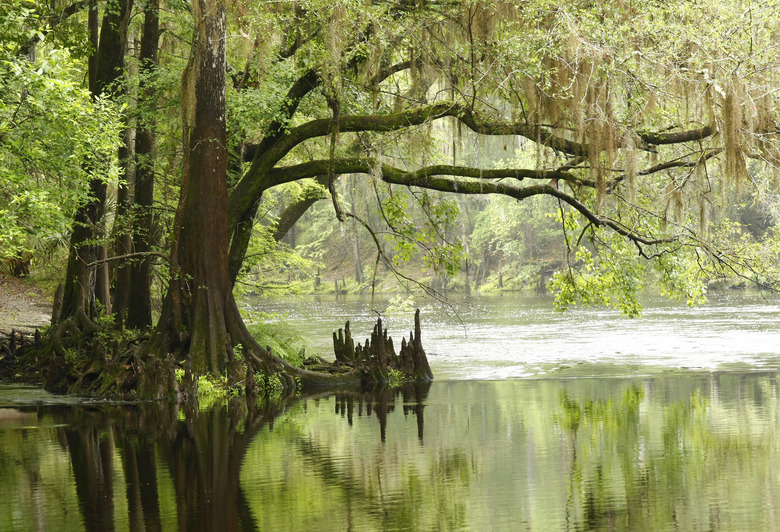Abiotic Factors In Natural Wetlands
A natural wetland is a complex ecosystem. Like other ecosystems, whether land- or water-based, many factors affect the form and function of the wetlands. Both biotic and abiotic factors and processes are integral to the natural wetland ecosystem. The term "biotic" refers to living things. The term "abiotic" refers to the materials, processes or factors that are nonliving.
Water
Water
Water itself is perhaps the quintessential abiotic factor in natural wetlands. Although essential to virtually all biological processes, water itself is nonliving and it can occur independently of living things. In natural wetlands, water is the medium in which the entire ecosystem exists and functions. Wetlands in regions that have been glaciated in the past — in the form of massive ice sheets — may owe their early beginnings to the powerful carving effects of the glacier. So, even water in that dramatically different form was a significant factor in the development of the wetlands.
Air
Air
Unlike water, air is composed of more than one chemical compound. Oxygen, nitrogen, carbon dioxide and several other gaseous substances form air's chemical composition. Air, especially the oxygen contained within it, is another critical abiotic factor in natural wetlands. Virtually any wetland ecosystem features many kinds of plants and animals. Green plants make use of carbon dioxide from the air; in turn, they release oxygen as a waste product. Animals do the inverse; they take in and use oxygen and give off carbon dioxide as a waste product. Although there are organisms that can and do live and grow in the absence of oxygen, the vast majority of life forms in a natural wetland — both under the water and above its surface — require oxygen from the air.
Sunlight
Sunlight
Light from the sun is an essential abiotic factor in natural wetlands. Sunlight provides the energy that plants need to carry out photosynthesis. That same energy is transmitted to other organisms in the wetland through the food chain or food web. And temperature, of course, is an abiotic factor directly related to the amount of energy the wetland receives from the sun.
Minerals
Minerals
Beneath the water, at the bottom of a natural wetland, are sedimentary materials of various kinds. Much of this material is organic or biotic and arises from the decomposing remains of living organisms in the wetland. But there is also a mineral component to this sedimentary material. Mineral particles of various kinds and sizes intermix with the organic material. Just as in terrestrial ecosystems, plants in the natural wetland must obtain abiotic mineral nutrients in order to live and grow. And minerals are not limited to the bottom sediments; they can be dissolved directly into the water, where they form a complex natural chemical mix that has a bearing on factors like pH, a measure of the acidity in the water.
Rocks
Rocks
In addition to the relatively small particles of mineral sediments, there are often larger rocks of various sizes and kinds in wetlands. Whether a massive, continuous layer of bedrock underlying the wetland and forming its foundation, or relatively smaller rocks that are under the water or that protrude above the surface, rocks are a significant abiotic factor in many wetlands. Besides providing substrates for plants and animals to either grow on or perch on, rocks — through natural weathering processes — gradually break down and provide mineral nutrients to the wetland ecosystem.
References
- University of Notre Dame; Effects of Abiotic Factors on Aquatic Macroinvertebrate Compositions and Distributions in Ten Vernal Pools at UNDERC; Joshua Vogel; 2005
- University of Michigan; Abiotic Factors Influencing the Abundance and Distribution of Marsh Marigolds Along Carp Creek; Larissa Hotra, et al.; June 2003
Cite This Article
MLA
Miller, Donald. "Abiotic Factors In Natural Wetlands" sciencing.com, https://www.sciencing.com/abiotic-factors-natural-wetlands-8506185/. 13 March 2018.
APA
Miller, Donald. (2018, March 13). Abiotic Factors In Natural Wetlands. sciencing.com. Retrieved from https://www.sciencing.com/abiotic-factors-natural-wetlands-8506185/
Chicago
Miller, Donald. Abiotic Factors In Natural Wetlands last modified August 30, 2022. https://www.sciencing.com/abiotic-factors-natural-wetlands-8506185/
